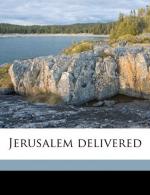|
This section contains 10,816 words (approx. 37 pages at 300 words per page) |

|
SOURCE: Zatti, Sergio. “Epic in the Age of Dissimulation: Tasso's Gerusalemme Liberata.” In Renaissance Transactions: Ariosto and Tasso, edited by Valeria Finucci, pp. 115-45. Durham, N.C.: Duke University Press, 1999.
In the following essay, Zatti argues that the “theme of dissimulation—the disguising of bodies, sentiments, or intentions—plays such a large role in the Gerusalemme liberata because Tasso's text is itself born from a discourse of dissimulation.”
The themes I wish to consider here may be counted among those that best justify the Gerusalemme liberata's placement among so-called mannerist texts. These themes absorb from mannerist literature the principle of a self-reflexive moment, wherein the semantic referent appears inscribed in the act of textual enunciation.1 In other words, I wish to argue that the theme of dissimulation—the disguising of bodies, sentiments, or intentions—plays such a large role in the Gerusalemme liberata because Tasso's text is...
|
This section contains 10,816 words (approx. 37 pages at 300 words per page) |

|


